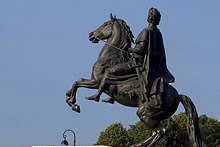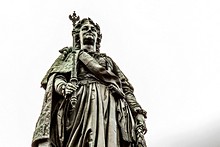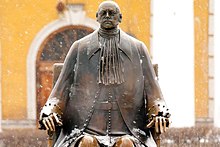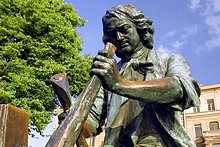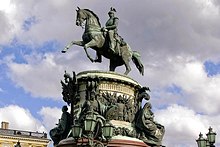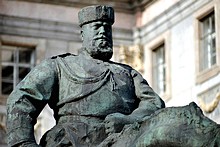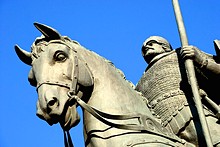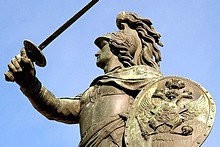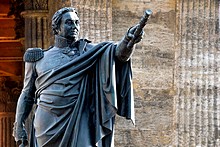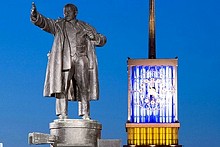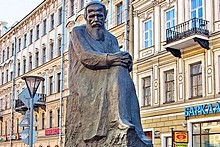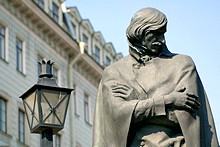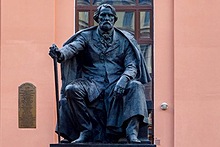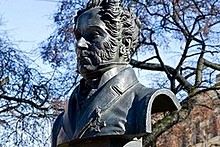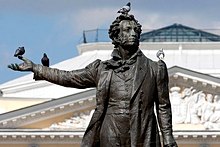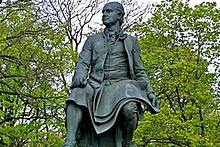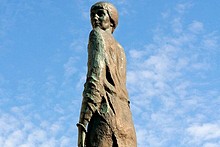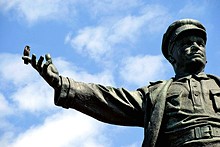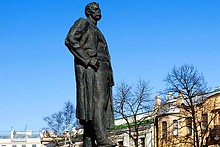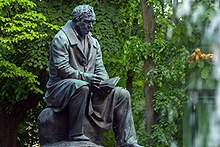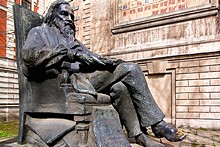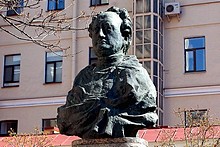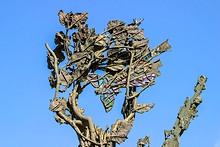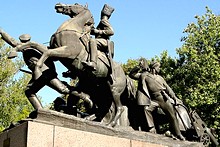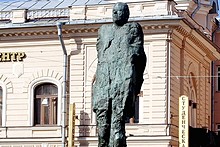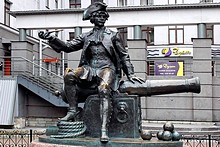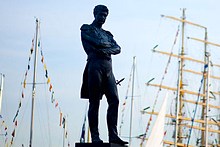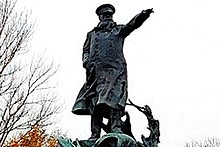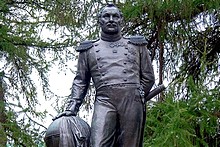Monuments to prominent people
The streets of St. Petersburg are decorated with several dozen statues of the most prominent people who have played their part in the development of the city and left their mark on its history and that of all mankind. Among them are great scientists, poets, writers, architects, statesmen, diplomats, soldiers, revolutionaries and explorers. Not all of them are Russian - St. Petersburg has always been a cosmopolitan city, and Germans, Italians, Frenchmen, Swedes and Britons, among others, have found fame in the city. These statues range from monumental sculpture celebrating Russia's Imperial and Soviet leaders to more modest monuments marking prominent Petersburgers' personal connections with the city.
This inspirational equestrian monument to Peter the Great, founder of St. Petersburg, is among the major landmarks of the city and is a definite must-see.
Located on Ostrovsky Square, a few dozen yards from Nevsky Prospekt, this monument is dedicated to Russia's magnificent Empress Catherine, who is surrounded by the most prominent men and women of her reign.
This Romanesque equestrian statue was created by the Italian architect Carlo Rastrelli soon after Peter the Great's death, although the statue wasn't erected as a monument until the very end of the 18th century.
This controversial statue to the founder of the city of St. Petersburg was created by the Russian-American sculptor Mikhail Shemiakin, and is a less than flattering portrayal of the Emperor. It is, however, a favorite with kids visiting the Peter and Paul Fortress.
This monument celebrating Peter the Great's rather unexpected shipbuilding skills was somehow mislaid during the 1930s, but luckily this copy was donated to the city in 1997 by the government of the Netherlands.
This equestrian statue to Emperor Nicholas I stands in front of St. Isaac's Cathedral and was built by the same architect, Auguste de Montferrand. It is notable for its innovative design, involving it balancing on just two legs.
This sturdy statue, depicting the ultra-conservative and undereducated Tsar Alexander III, was considered scandalous when first unveiled. It now stands in the courtyard of the Marble Palace where Vladimir Lenin's armored car once stood.
Alexander II is one of Imperial Russia's most revered leaders, responsible for wide-scale reforms including the emancipation of the serfs. This recently erected statue finally provides St. Petersburg with a monument to him.
This modern monument commemorates the great medieval prince and saint who, like Peter the Great after him, defended Russia against invading forces on the banks of the Neva River.
Standing between the Field of Mars and the River Neva, this monument to the great 18th century Russian general was the first in St. Petersburg to be built entirely by Russian craftsmen.
Boris Orlovsky's statues of Mikhail Kutuzov and Barclay de Tolley, two of the great Generals who led Russia to victory in the Napoleonic Wars, were erected outside Kazan Cathedral in 1838.
This seminal statue, erected at the place where Lenin made a historic speech on his return from exile in 1917, was among the first to appear after his death and established a prototype for thousands of monuments in the Soviet Union.
This monument to one of Russia's most prominent writers was unveiled in the spring of 1997 just off Vladimirskaya Square and only one block away from the Dostoyevsky Museum.
The statue of the great Russian writer Nikolai Gogol was unveiled on Malaya Konyushennaya Ulitsa on 1997. Although Gogol only lived in St. Petersburg for a few years, the city made an indelible impression on his work.
The statue of the Russian writer Ivan Turgenev was unveiled on Manezhnaya Ploshchad in the summer of 2001, not far from the old editorial offices of the magazine Sovremennik, or The Contemporary, in which Turgenev published his work.
The Alexander Garden in front of the Admiralty was decorated at the end of the 19th century with a series of busts of the great and good of St. Petersburg from the previous hundred years.
It's no exaggeration to say that Italian architects created the face of St. Petersburg in the 18th and 19th centuries. These busts in the very centre of the city honour four of the greatest among them.
Erected to mark the 250th anniversary of the founding of St. Petersburg, this statue on Arts Square is among the best of the many monuments in the city to honour Russia's best-loved poet.
Located between the main building of St. Petersburg State University and the Academy of Sciences, this modern monument celebrates the life and career of the great 18th century scientist, Mikhail Lomonosov.
Facing the Monument to Victims of Political Repression and Kresty Prison across the Neva, this statue commemorates the great poet whose life and works are inextricably linked with sufferings of Petersburgers during the Soviet period.
This huge Socialist Realist statue in the heart of St. Petersburg's historic workers' district commemorates the Bolshevik commissar who spearheaded industrial development in Leningrad.
Located close to Gorky's former home in St. Petersburg, this monument commemorates the writer venerated higher than any other in the Soviet Union, but who in fact enjoyed very ambiguous relations with the Bolshevik government.
This charming monument, commemorating the "Russian LaFontaine" whose satirical fables made him one of the best loved authors of the 19th century, is richly decorated with animal figures modeled from life by the great sculptor, Peter Clodt.
An intimate portrayal of the great chemist in his later years, this statue is situated outside the building where Mendeleev, as director of the Bureau of Weights and Measures, established chemical standards for the production of vodka.
The bust of Johann Wolfgang Goethe was unveiled in 1999 in front of the Lutheran Cathedral of SS. Peter and Paul on Nevsky Prospekt for the 250th anniversary of the great German poet and philosopher's birth.
The Swedish inventor of dynamite and founder of the Nobel Prizes spent much of his early life in St. Petersburg, where his father owned a factory. This modern abstract sculpture honours his links to the city.
A Red Army commander killed in 1919, Chapaev is an almost mythical figure of the Revolution, thanks to a famous novel and film romanticizing his deeds. That process is continued by this massive Socialist Realist monument.
A nuclear physicist who gained international fame as a dissident and human rights activist, Andrey Sakharov had no personal connections to St. Petersburg, so this prominently placed monument is a testament to the respect accorded him.
The man after whom Vasilevskiy Island is purportedly named, Vasiliy Korchmin was an engineer and inventor, a friend of Peter the Great and commander of the artillery company that protected St. Petersburg in the first years of the city.
Most famous for leading Russia's first round-the-world voyage, Admiral von Krusenstern worked for many years as director of the Naval Cadet College, in front of which a monument to him now stands.
Located in the naval town of Kronshtadt, this imposing monument commemorates a commander of the Russian fleet killed in action in the Russo-Japanese War, who also designed the first icebreaker.
Among the greatest names ever to have served in the Russian Navy, von Bellingshausen twice circumnavigated the globe, and discovered the continent of Antarctica.

